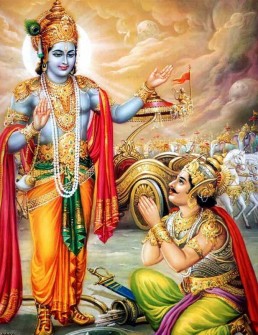Here, in the stanza, the path of “gradual liberation” (Krama-mukti) is explained. According to the Upanishadic tradition, “he who lived a life of rituals (Karmas) and worship (Upasana), to enjoy the result so accrued, will walk the ‘Path-of-the-gods’ (Devayana) and entering through the Sun, will go beyond it to Brahma-loka.” There he enjoys the super-sensuous Bliss till the end of the “cycle,” when, along with the Creator, he gets total liberation. This ‘Path-of-the-gods,’ is indicated here by the terms borrowed from the Upanishads which have a wealth of suggestiveness to all students of the Rishi-declarations.
FIRE, FLAME, DAY-TIME, THE BRIGHT FORTNIGHT, THE SIX MONTHS OF THE NORTHERN SOLSTICE OF THE SUN — These indicate the “Path-of-the-gods” presided over by the Sun. In the Prashnopanishad this has been vividly brought out when the Upanishad supplies the students with a theory of the creation of multiplicity from the one Great Truth. It is explained that Prajapati, the Creator, Himself became the Sun and the Moon, and these two phenomenal objects are mentioned as representing energy and matter respectively.
Identifying with the Dynamic Centre in himself, a seeker tries to live the life. Such an Upasaka of Truth, at the time of his departure from his present manifestation in the world, comes to think of the object of contemplation of his whole life-time, and naturally, he goes to the world of his thoughts — “as you think so you become.” By entertaining evolutionary thoughts in one’s mind all through one’s life, one must, after leaving the present embodiment, walk the ascending path of evolution, the ‘Path-of-the-gods,’ indicated here as “THE PATH OF LIGHT AND FIRE, OF DAY TIME, OF THE BRIGHT FORTNIGHT, OF THE NORTHERN SOLSTICE OF THE SUN.” Thus, in the mystic language of the Upanishads, the path pursued by those who are great devotees of Brahman, the Eternal, is described as stretching towards the North. These implications are all epitomised and the Upanishadic Rishis often use the term “Northern Route” to indicate “the Path of the Gradual Liberation.”
AS CONTRASTED WITH THIS PATH OF NO-RETURN THERE IS THE PATH OF SURE-RETURN WHICH IS EXPLAINED IN THE FOLLOWING:

